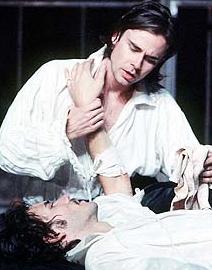SEARCH
REVIEWS
FEATURES
NEWS
Etcetera and
Short Term Listings
LISTINGS
Broadway
Off-Broadway
NYC Restaurants
BOOKS and CDs
OTHER PLACES
Berkshires
London
California
DC
Philadelphia
Elsewhere
QUOTES
On TKTS
PLAYWRIGHTS' ALBUMS
LETTERS TO EDITOR
FILM
LINKS
MISCELLANEOUS
Free Updates
Masthead
Writing for Us
A CurtainUp Review
Kit Marlowe

Sam Trammel, Christian Camargo
(Photo: Michael Daniel) |
In Shakespeare In Love, Christopher Marlowe is a minor character. In Kit Marlowe David Grimm disposes of the Bard with a brief reference and concentrates on the man often considered Shakespeare's greatest rival and influence. Marlowe's life was cloaked in mystery. The facts are that he established blank verse, was a poet and author of four major and two minor plays (the best known being Tambourlaine the Great, The Tragical History of Doctor Faustus and The Jew of Malta, which was the precursor to Shakespeare's The Merchant of Venice). The rumors are that he was a homosexual and a spy for Queen Elizabeth's man, Sir Francis Walsingham.
Mr. Grimm has written a fascinating and original play that brims with drama. He brushes his story with the aura of history but leaves himself free to put his own stamp on characters bearing the names of real people and to toss in a few of his own invention. Christopher Marlowe becomes Kit -- a fiery, hyperactive college dropout with enough energy to explain how he could indulge his appetite for sex and adventure and still turn out a substantial body of literature in a very short time.
Thomas Walsingham is an invented best friend, a young aristocrat who loves him passionately but also feels he must marry and look after his estate. Since he also happens to be the wicked Sir Francis's nephew, he is the conduit (unwillingly so) to help Kit strike his Faustian bargain.
To tell the story of Marlowe's life from the time he left Cambridge to his violent death at age twenty-nine the playwright uses bits and pieces of history associated with him. To deepen his portrait of the man and enliven the drama, the main man, as well as several subsidiary characters are patterned on several characters from Marlowe's plays.
Thus Kit is young, fiery, starved for a fully realized life— like Tambourlaine, the hero of Marlowe's first "hit" play. In a case of Grimm's faction following Marlowe's fiction, the Tambourlaine role model, Sir Walter Raleigh, becomes a character in Kit Marlowe. In the same way, Marlowe's alleged spy activities are given credence by making Walsingham the central villain and a composite of Doctor Faustus and Barabas of The Jew of Malta.
The blending of fact, rumor and borrowed literary characters makes for challenging playwriting, though fans of Marlowe's work may wish there was more of Marlowe as a literary man than as a dashing young adventurer. I liked much of what I saw but was less than enthralled with some of the excesses in acting and writing. For example, not satisfied to bring off this dramaturgical feat of patchworking Marlowe's plays into his story, the playwright has written in a style that might be deemed a homage to Marlowe and the Bard. But as Kit's unbridled ambition proves to be his undoing, so Mr. Grimm's linguistic aim is a few rungs above his reach.
Christian Camargo does a fine job of projecting Kit's hyperactive intensity and manages to deliver this faux Shakespearean dialogue with spirited clarity. The same applies to Sam Trammel, who as the fictional Thomas is the most touching and real character we meet. Neither clarity or spirit, however, can prevent the many long and overly poetical lines Camargo, Trammel and company must deliver from often sounding like the steamy prose of a bodice ripper romance novel (without bodices since this is an all male cast).
As you've probably guessed, Kit Marlowe falls somewhat short of being the important artistic work it aspires to be. Yet, it's a good yarn full of colorful scenes: Kit's first humiliating encounter with the actor Edward Alleyn (Richard Ziman giving a fine display of pomposity). . . the bloody sealing of the Faustian bargain that sends Kit to France to ferret out a group that wants to put Mary Stuart on the throne. . . the shift in his fortunes as a playwright that actually brings him face to face with Walter Raleigh (a nicely understated performance by Keith David). . . and the inevitable fate of Kit and Thomas -- actual death for one, and the death of capitulating to conformity for the other.
It all plays a bit like a cross between old "B" adventure movies now tagged "classics" by movie channels and video stores and the classy film Elizabeth. Unlike that film's rather benign portrayal of Walsingham by Geoffrey Rush, the Walsingham of John DeVries is so evil that there are times he is almost funny. Robert Sella clearly has great fun with an effete Lord Essex who is over the top foppish. If 1940's swashbuckling movie idol Errol Flynn, the Essex of the golden oldie Elizabeth and Essex, could see him, he would leap out of his grave and challenge Sella to a duel.
While I'm making references to movies, Kit Marlowe is definitely X-rated: X for violence that includes garroting, hanging and torture. X for illicit activities ranging from sexual encounters (homesexual) a smoking scene at Sir Walter Raleigh's home in which something stronger than plain tobacco (marijuana?) is lit up. X for full frontal nudity -- unlike the much hyped flash of male genitalia in the recently opened Broadway musical, ( The Full Monty). Christian Camargo's rope swinging entrance truly delivers the full monty. His rather lengthy exposure does serve the purpose of immediately establishing Kit as a free spirit -- a second nude scene in which the beautiful young actor (Ned Stresen-Reuter) is shown covered with torture marks serves as a stark, cautionary lesson about what happens to free spirits in Walsingham's cruel world.
Brian Kulik smoothly leads the large cast through the play's eventful six years. The set, costumes and lighting emphasize the sense of watching an old black and white adventure movie and effectively convey the atmosphere of a world where people are literally and figuratively trapped within the harsh dictates of church and state.
On balance, Kit Marlowe's assets outweigh its shortcomings. The clever use of the characters from Marlowe's plays to develop Mr. Grimm's characters and plot make for an entertaining theatrical evening. The generously sized cast and mood supporting staging provide additional rewards. Perhaps this new work will even inspire some unfamiliar with Marlowe's writing to read some of his plays and poems.
| KIT MARLOWE
ByDavid Grimm Directed by Brian Kulick Cast: Christian Camargo, Keith David, Jon DeVries, Sam Trammell, Craig Bockhorn, Bostin Christopher, David Patrick Kelly, Chris Kipiniak, Martin Rayner, Robert Sella, Ned Stresen-Reuter, Richard Ziman Set Design: Narelle Sissons Lighting Design: Mimi Jordan Sherin & D.M. Wood Costume Design: Anita Yavich Sound Design:Kurt B. Kellenberger Running time: 2 and 1/2 hours including intermission Joseph Papp Public/Newman/ 425 Lafayette St. (Astor Place/4th St), 239-6200 Tue - Sat at 8pm; Sat & Sun at 2pm; Sun at 7pm -$45 10/31//2000-12/03/2000; opened11/19 Reviewed by Elyse Sommer based on 11/17 performance |

